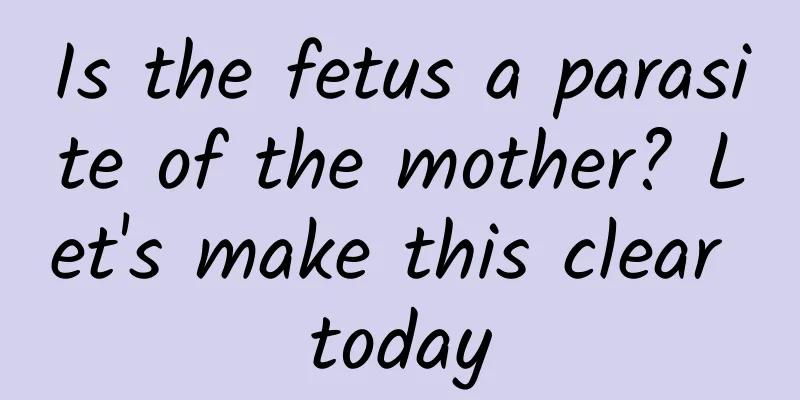Is the fetus a parasite of the mother? Let's make this clear today

|
Rumors Nowadays, more and more young people are "afraid of marriage and pregnancy". Many young people have heard the following sayings↓ ▶ Pregnancy is a pure sacrifice for the mother without any benefit ▶ The relationship between the fetus and the mother is parasitic ▶ If there is no placenta, the fetus will absorb all the nutrients from the mother... Is this really the case? Is pregnancy really such a scary thing? I believe that after reading the following article, you will have a clearer understanding of childbirth. Image source: Copyright Library "Ten months of pregnancy and one day of delivery" is something that the mother and the fetus need to experience together. From the time the fertilized egg implants in the uterus to the time the embryo develops into a fetus and finally leaves the mother's body to become a new life and a new individual, what do the mother and the fetus experience during this process? What kind of coexistence do they have? I will give a brief explanation here, hoping to help my female compatriots have a clearer understanding of this physiological phenomenon. The mother provides good Growth and development environment After the embryo implants in the mother's uterus and forms a pregnancy, as the pregnancy progresses, the fetus, placenta and amniotic fluid are formed and develop, the mother's uterus gradually enlarges, the isthmus of the uterus softens and elongates to form the lower uterine segment, the cervix softens, and the cervical mucus increases, all of which are in full preparation for the growth and delivery of the fetus. The endometrium during pregnancy is called decidual tissue . It can be divided into three parts: basal decidua, pericranium, and true decidua according to the positional relationship between the embryo and the endometrium. The basal decidua is the maternal part of the placenta, and the pericranium envelops the blastocyst. The decidua can protect and nourish the placenta, provide a safe environment for fetal development, and ensure normal fetal development. The placenta is located between the fetus and the mother. It is an important organ for material exchange between the two and an important component of the connection between the two. Another important link between the placenta and the fetus is the umbilical cord, which contains an umbilical vein and two umbilical arteries. Gas exchange, nutrient supply, and fetal metabolic products between mother and fetus are all achieved through the umbilical cord and placenta. Blood flowing through the maternal uterine artery flows into the intervillous space of the placenta. Through the exchange of substances in the intervillous space, the mother's nutrients and oxygen flow from the capillary network of the villi through the umbilical vein, transporting oxygen and nutrients to the fetus. The fetal metabolic products are then transported back to the intervillous space through the umbilical artery and enter the mother's body through the placental circulation for excretion. The fetal blood in the placental villus vessels and the maternal blood in the intervillous spaces do not communicate directly, but rather exchange substances through the vascular walls, stroma and villus epithelial cells in the villi, mainly through osmosis and diffusion. Through these exchanges of substances, the fetus obtains sufficient nutrition and excretes metabolic products, ensuring that the fetus can grow and mature well in the mother's body. Image source: Copyright Library The fetus provides multiple protections for the mother In the process of the mother's pregnancy, the fetus will inevitably benefit from the mother's body. So for the mother, is it just giving without any benefit? Some people even suspect that the mother and the fetus have a parasitic relationship. Is this true? Parasitism refers to two organisms living together, with the parasitized party providing nutrients and living quarters to the parasitoid. During the parasitic process, one party benefits while the other suffers. During pregnancy, the mother and the fetus are the same organism, and there is no competition between the two. The mother's body state will also change during the process of nurturing the fetus, and many of these changes are also a kind of protection for the mother. The mother stops ovulating during pregnancy, which plays a good protective role on the ovaries. The ovaries can rest for a period of time during pregnancy, which is beneficial to the protection of ovarian function and the prevention of premature ovarian failure. At the same time, resting the ovaries is also very beneficial for preventing the occurrence of ovarian tumors. During pregnancy, the endometrium forms decidua under the action of progesterone and no longer sheds periodically, which is why menstruation does not occur during pregnancy. During pregnancy, the endometrium is protected by progesterone, which can prevent the occurrence of endometrial lesions. There is currently a lot of evidence that shows that women who do not have children will increase the incidence of endometrial lesions and even endometrial malignancies. In addition, timely and continuous breastfeeding after childbirth can effectively prevent breast diseases and even malignant breast tumors. These are all benefits that nurturing a fetus brings to the mother. In addition, during the process of the mother nurturing a new life, does the fetus absorb all the nutrients from the pregnant woman? Of course not. During pregnancy, the mother's heart capacity and blood volume increase, and the mother's water and sodium retention increases under the action of progesterone. These lay the foundation for the fetal nutritional supply, and also provide additional reserves for the fetal circulation and reasonable bleeding of the mother during delivery. Generally speaking, the nutrition that the mother provides to the fetus is provided on the basis of ensuring her own basic needs (limited liability supply). During pregnancy, the fetus absorbs more reserved nutrition beyond the mother's own needs, rather than all the mother's nutrition. Therefore, it is important for pregnant women to have a reasonable diet and balanced nutrition. Excess or insufficient nutrition supply is not conducive to the health of themselves and the fetus. Image source: Copyright Library The relationship between mother and fetus during pregnancy should be "working together and achieving each other". A mother with balanced nutrition and good health can nourish the growth of the fetus during pregnancy; the fetus's pregnancy also provides many protective effects for the mother's reproductive system. In this wonderful and magical process, the mother and fetus rely on each other and achieve each other. This is the wonderful magic of nurturing life! Author: Zhai Yan, Chief Physician of Obstetrics and Gynecology Department, Beijing Chaoyang Hospital, Capital Medical University Review | Zou Yan, Chief Physician, National Health Commission Institute of Science and Technology Rao Lin, Deputy Director of Nursing Department, China Welfare Institute International Peace Maternity and Child Health Hospital The article is produced by "Science Refutes Facts" (ID: Science_Facts). Please indicate the source when reprinting. |
<<: Guqin from the Han Dynasty: A piece of music passed down through the ages (Part 1)
>>: Where are the best cherry blossoms in China? Take this cherry blossom map
Recommend
Q: In the AI world, which company is the best at bulldozer production?
If someone asks you, "Which company has the ...
Will the cybersecurity companies that disappeared in the mobile phone era become life firewalls in the field of smart cars?
Earlier this month, a piece of news once again ar...
How to position a short video account?
Nowadays, many people regard shooting short video...
2019 traffic growth inventory!
2019 has not been an easy year, so today we will ...
Detailed explanation of the working principle of LiveData in advanced Android source code
[[422179]] This article is reprinted from the WeC...
"Only working in the fields is the happiest!" Today, we miss you...
The yield of double-season rice exceeded 1,600 ki...
OPPO promotion app advertising process explanation
1. OPPO app distribution advertising delivery pro...
How to optimize account structure knowledge? What is the basic structure of a bidding account?
Many people don’t know how to optimize a Baidu pr...
Practical methodology for community operation!
This article is a review article. The main task w...
Do bee-related products really have health or therapeutic effects?
Beekeeping, as a traditional agricultural product...
Puzzle & Dragons enters China market, why did it give up self-development and choose Cocos engine?
The only authorized Chinese version of the popula...
Tech Neo November Issue: Container Platform Management Practices
51CTO Network+ Platform launched the "TechNe...
Takata expresses condolences to victims, but restructuring plan favors automakers
According to foreign media reports, on June 27, t...
How to get more recommendations on self-media platforms?
This article will talk to you about the article r...
Blood is red, why are veins blue?
In Europe, "blue blood" was once a symb...









